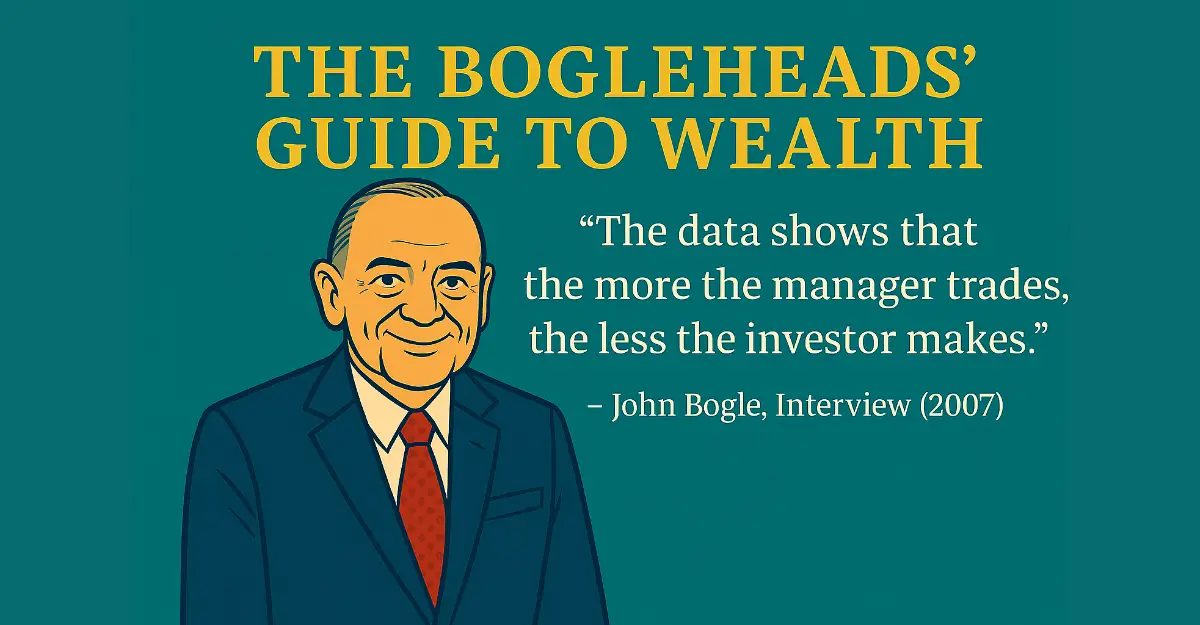In the high-stakes world of finance, where complex strategies and a constant chase for market-beating returns often dominate, the legacy of John Bogle stands as a powerful testament to the enduring wisdom of simplicity. As the founder of The Vanguard Group, Bogle didn't seek to outsmart the market; he sought to empower the everyday investor by creating a strategy that was both highly effective and remarkably straightforward. His philosophy, centered on the humble index fund, sparked a revolution that continues to shape how millions of people build their wealth.
While market watchers often focus on the detailed business analysis championed by Warren Buffett, Bogle's approach offers a vital and accessible alternative for building a resilient investment portfolio. This article will explore the core tenets of his investing genius, dissecting how his focus on low costs, broad diversification, and disciplined patience provides a clear and proven path to long-term financial success for all types of investors. We will delve into his most famous quotes, provide practical tips for implementation, and examine why his simple yet profound wisdom remains as relevant today as it was decades ago.
The Pillars of John Bogle's Indexing Philosophy
1. The Revolutionary Power of the Index Fund: A Simple Path to Market Returns
At the heart of Bogle's philosophy is the understanding that beating the market consistently is a statistical impossibility for most, and an expensive endeavor for all. His solution was groundbreaking in its simplicity: instead of paying a manager to try and pick winning stocks, why not simply own the entire market? This insight led to the creation of the first index fund for individual investors, forever changing the landscape of finance.
The logic is elegantly brutal: in a zero-sum game before costs, the average investor in the market must, by definition, earn the average market return. The moment you introduce costs—management fees, trading commissions, and administrative expenses—you are guaranteed to underperform the market by exactly the amount of those costs. Bogle's central thesis was that by minimizing those costs, investors could capture a near-market return, an outcome that, over the long run, would beat a vast majority of actively managed funds.
Understanding the "Haystack" Analogy:
"Don't look for the needle in the haystack. Just buy the haystack!" Source: John C. Bogle, The Little Book of Common Sense Investing, 2007.
Bogle's legendary quote is a direct challenge to the practice of 'stock picking,' or trying to outperform the market by finding a few winning stocks. He argued that since it is nearly impossible to consistently pick market-beating stocks, a far more reliable and efficient strategy is to simply own the entire market (the 'haystack') through a low-cost index fund. An index fund passively holds all the stocks in a particular index, like the S&P 500, ensuring you get the average return of the market itself. This eliminates the risk of picking the wrong individual stocks while ensuring you are always fully diversified.
Actionable Tip: As a practice consistent with Bogle’s philosophy, you might consider making a low-cost, broadly diversified index fund the foundation of your long-term strategy. Funds that track the total U.S. stock market or a global index are often used as starting points for a disciplined, buy-and-hold approach. Prioritize funds with the lowest possible expense ratios, as these tiny percentages can have a massive impact on your wealth over time.
2. The Two Greatest Enemies: The Silent Drag of Fees and the Danger of Emotions
Bogle's genius was not just in what to do, but what to avoid. He relentlessly campaigned against the two most corrosive forces that erode an investor's long-term returns: high costs and emotional decision-making. His entire strategy was designed to systematically eliminate both.
He meticulously demonstrated how even a modest 1% annual fee could reduce an investor's total return by as much as 50% over a 50-year period due to the insidious effect of compounding. This tireless focus on fees made him a consumer champion for the average investor.
The Bogle Rule on Fees and Emotions:
"The two greatest enemies of the equity investor are expenses and emotions." Source: John C. Bogle, Common Sense on Mutual Funds, 1999.
As Bogle stated in his seminal work, he understood that high management fees and trading costs (expenses) create a constant drag on performance. In parallel, emotional decisions driven by fear and greed (emotions) often lead investors to buy high and sell low. His solution was to remove both of these threats with a simple, low-cost index fund that you buy and hold for the long term.
Actionable Tip: Consistent with Bogle's principles, a good practice is to scrutinize the expense ratio of any investment you evaluate. Many investors favor low-cost index funds and ETFs over actively managed funds with high fees. Furthermore, adopting a disciplined, long-term approach can help insulate you from daily market noise, and automating your contributions can help separate your investing decisions from your emotions.
3. The Enduring Virtue of Patience: Time, Not Timing, is Your Ally
In a world of constant news cycles and instant gratification, John Bogle's message on patience and long-term holding is more relevant than ever. He firmly believed that the most powerful force in investing is not market timing or stock selection, but the simple, unglamorous power of compounding over a very long time horizon.
His approach to time was simple: the stock market is volatile in the short term, but its long-term trajectory has historically been upwards. An investor who tries to time the market's swings inevitably gets it wrong, missing out on the market's best-performing days, which often follow its worst days. Bogle’s data showed that the vast majority of active traders failed to beat the market due to this very issue.
The Bogle Rule on Time:
"The winning strategy in investing is to own the entire stock market, hold it forever, and pay the lowest possible costs." Source: John C. Bogle, Public statements and interviews, frequently cited.
Bogle believed that an investor's best friend is time. This quote highlights the futility of trying to time the market. Instead of constantly buying and selling in an attempt to capture fleeting gains, Bogle's approach is to simply stay the course, weathering market ups and downs, and letting the market's long-term upward trend do the work for you.
Actionable Tip: Based on this philosophy, it is often suggested that investors resist the urge to check their portfolio's performance daily. Instead, many focus on their long-term goals and stick to a predetermined investment plan, regardless of short-term market volatility. For a young investor, time is a powerful asset, so starting early is often recommended. For those closer to retirement, maintaining your asset allocation and avoiding panic selling is paramount.
4. The Unexpected Synergy: Bogle and Buffett's Complementary Wisdom
While Bogle and Buffett are often seen as philosophical rivals—one an indexer, the other a stock picker—their core tenets are surprisingly complementary. Both men share a deep-seated respect for fundamental principles and a profound understanding of what truly drives long-term success. They both knew that the path to wealth was paved with discipline, patience, and a steadfast focus on value, albeit through different lenses.
Common Ground: Long-Term Horizon and Disciplined Patience:
Both Buffett and Bogle would agree that successful investing is a marathon, not a sprint. Buffett's famous quote, "Our favorite holding period is forever," echoes Bogle's belief in owning the market for a lifetime. Both men valued patience and a steadfast refusal to be swayed by short-term market noise. Their advice converges on the idea that the power of compounding over time is the most potent force in finance, and that a buy-and-hold strategy is the only way to harness it.
Common Ground: The Primacy of Value:
Buffett's focus on 'intrinsic value' and buying great companies at a fair price is a form of value investing. Bogle's indexing is a form of 'average-value' investing—you get a great price on the entire market every day. While their methods differ, their underlying belief in buying something for a fair price and holding it for the long run is a shared foundation. Bogle simply democratized the process by making it accessible to every investor, without the need for extensive research.
Actionable Tip: When applying these principles, a common strategy for many investors is to combine both approaches. You could use Bogle's low-cost index funds as the stable, diversified core of your **investment portfolio**. Then, if you have the time, skill, and interest, you might use a small portion of your portfolio to apply Buffett’s principles by investing in a few individual stocks you truly understand. This gives you the best of both worlds: a highly-effective default strategy with a touch of personal engagement.
5. Implementing a "Boglehead" Portfolio Strategy: The Three-Fund Portfolio
Bogle's philosophy is not just theoretical; it has spawned a highly-regarded and passionate community of investors known as "Bogleheads." The Bogleheads embrace his principles and often simplify their portfolios into a highly effective, easy-to-manage structure: the "three-fund portfolio." This simple strategy provides a perfect example of how to put Bogle’s ideas into practice.
The Three-Fund Portfolio Explained:
A three-fund portfolio typically consists of three low-cost index funds:
- A Total U.S. Stock Market Index Fund: This provides broad exposure to the entire U.S. equity market.
- A Total International Stock Market Index Fund: This provides diversification outside the U.S., which Bogle considered crucial for a balanced portfolio.
- A Total U.S. Bond Market Index Fund: This serves as the fixed-income portion, reducing volatility and providing stability to the portfolio, especially as an investor approaches retirement.
The allocation between these three funds depends entirely on an investor's risk tolerance, age, and financial goals. A younger investor might be 80% stocks and 20% bonds, while someone nearing retirement might be 40% stocks and 60% bonds.
Actionable Tip: To start building a Boglehead-style portfolio, you would typically choose a target asset allocation (e.g., 60% stocks, 40% bonds) and then select the corresponding low-cost index funds to fulfill that allocation. Regularly, or at least once a year, rebalancing your portfolio to maintain your chosen percentages is a key part of this disciplined process. This simple action can help automate the buy-low, sell-high strategy and keep you focused on your long-term plan.
Conclusion: Investing with Clarity, Confidence, and Bogle's Simplicity
The wisdom of John Bogle offers a liberating perspective on investing. By focusing on what is controllable—costs, time, and emotions—he provided a proven, reliable, and accessible path to building wealth. His strategy is a powerful reminder that in investing, as in life, the most sophisticated solutions are often found in the most simple ideas.
For investors who manage complex portfolios across multiple accounts, Bogle’s principles can bring order and clarity. By establishing a low-cost, index-based core and committing to a long-term plan, you can navigate the markets with confidence and avoid the common pitfalls that derail so many. The Boglehead approach is a testament to the fact that you don't need a finance degree to be a successful investor; you simply need discipline, patience, and a commitment to keeping costs low.
Ready to apply these timeless principles to your own investment portfolio? MyStockData provides the tools to consolidate your data, track your asset allocation, and monitor your progress across all your accounts, helping you stay disciplined and focused on your long-term financial goals.
Disclaimer
Investing involves risk, including the possible loss of principal. This article is for informational purposes only and does not constitute financial advice. Always conduct your own due diligence and consult with a qualified financial professional before making investment decisions. Past performance is not indicative of future results.





